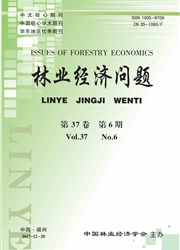

 中文摘要:
中文摘要:
基于农户家庭主要劳动成员就业形态的分析对农户进行分类,采用四川省雅安市农户调查数据,对不同类型农户的林地经营行为和技术效率进行了分析,并探讨影响农户林地技术效率的外生变量,研究结果表明:第一,不同类型农户的林地经营结构、投入产出、技术效率都存在差异,男女共同从事林业生产农户的林地技术效率最高;第二,林业主要劳动者的受教育程度、技术培训、从事林业生产的年限、家庭劳动力数量对林地技术效率具有正向作用,外出务工对林地技术效率具有负向作用,农户类型对林地技术效率影响显著;第三,林地质量和距离农户家的距离对林地技术效率有正向影响,林地地块数对林地技术效率有负向影响。因此,得到政策启示:男女共同从事林业生产农户占据未来西部地区林地经营主体重要的位置;农户兼业化和从事林业生产的“半工半林、男工女林”在短期内不会改变。
 英文摘要:
英文摘要:
Based on the households classification according to employment of the main labors, using the household level survey data of forestland management in Yaan city of Sichuan province, this paper analyses the forestland management behavior and the production technical efficiency of the different types’ households, the exogenous variables influencing the technical efficiency is discussed. The con-clusions are that firstly, the households in different type is different between the forestland management structure, inputs and outputs, technical efficiency, The highest technical efficiency is the households that the male and female labor are engaged in forestry production. Secondly, the technical efficiency loss shows that the human resource investment including formal education and technical training, ex-perience from forestry and labor quantity have a positive effect on the technical efficiency of households’ forestland management, while the non-agricultural employment has a negative effect and household types show a marked effect. Thirdly, the forestland quality and the distance from home to forestland have a positive effect on the technical efficiency, but the number of forestland plots has a negative im-pact on the technical efficiency. The policy implications are that the households of the male and female labor engaged in forestry production will play an important role in the future forestland management in western China, the households’ characteristic of involving non-agricultural sectors and the phenomenon of “half labor and half peasant, male off-farm work and female on farm” will not change in the shortterm.
 同期刊论文项目
同期刊论文项目
 同项目期刊论文
同项目期刊论文
 期刊信息
期刊信息
